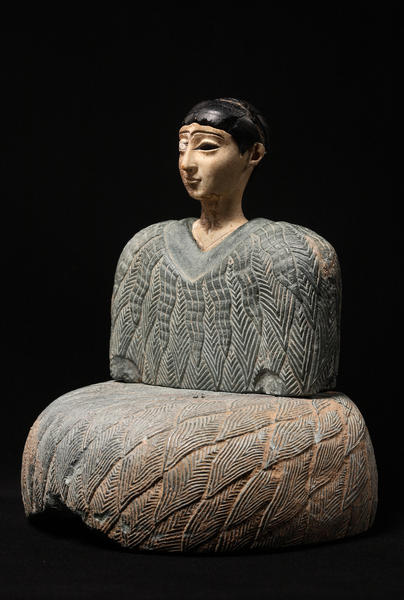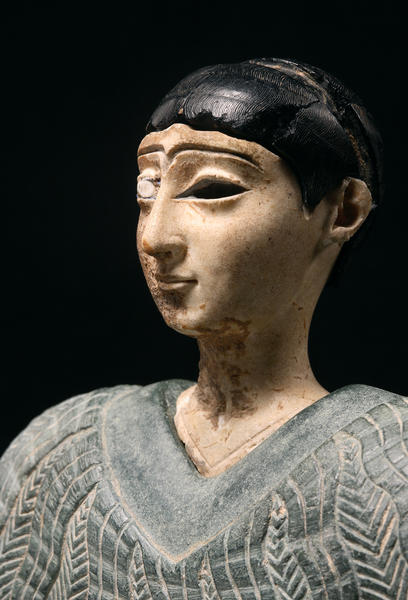女神坐像
- バクトリア
- 前三千年紀末期~前二千年紀初期
- 石、瀝青
この羊毛の房がつけられた衣装をまとう姿の石製婦人坐像の様式は、西中央アジアに特有なものである。緑泥岩の体躯、それと鮮やかな対比を見せる白い石灰岩の端整な首と顔面が印象的である。頭部の漆黒の髪を表現した瀝青の表面には大変繊細な線が刻まれている。最近ではナマーズガ文化の栄えたトルクメニスタン・マルギアナ地方から同類の彫刻の断片が発見されているが、この地域は古代エラム文化に親しい要素を持っていた。この婦人の衣装と右側に足先を見せる座り方は、エラムの豊穣と戦いの女神キリリサの姉妹神ナルンデの表現に通じるものがあり、この婦人像も太地母神系の女神であった可能性が考えられる。かつて眼窩にラピスラズリと貝あるいは石灰岩で眼が象嵌されていた。正面からは大変鋭い眼差しが、他面また大変やさしいほほえみの感じられる女神像である。
Catalogue Entry
The style of this stone figure, which shows a seated woman wearing a flounced garment of lambswool, is typical of works from western Central Asia. The figure’s chlorite torso contrasts strikingly with the handsome face and neck of white limestone, and the jet black hair is rendered in bitumen with fine incised lines. Fragments of a similar style of sculpture have recently been discovered in the Margiana region of Turkmenistan, an area where the ancient Namazga culture once flourished and which had close ties with the culture of ancient Elam. The present figure’s garment and the way she sits, with her tips of toes showing on the right, are common to representations of Narunde, sister goddess of the fertility and war goddess Kiririsa, and it is possible that this sculpture depicts a goddess of the same earth-mother type. The figure’s eye sockets were once inlaid with eyes of lapis lazuli and shell or limestone. She seems to stare penetratingly when viewed from the front, but from other angles her countenance seems gentle and smiling.
女神坐像
緑泥岩の衣装に瀝青の黒髪、温かみのある石灰岩のお顔は優しい微笑みをたたえる。さながら現代のファー・コートを着けた、ボーイッシュな髪の現代風の美形。
このカウナケスと呼ばれる装いが、造化の命を表す緑色の石で造られているのは偶然ではない。こうした謎めいた西中央アジアの女神は死者に寄り添い守ったのか、墓穴とは区切られながらも隣接する場所から。儀器とともに発見されたものもある。
かつては石灰岩の白い両腕をひざにのせ、髪には金のヘアバンドを着けていたようである。はり出した下半身右側の二穴は、この像がここから足先を見せる横座りの女神であったことを示している。
Seated Goddess
This figure has garments of chlorite, black hair made from bitumen and a face of warm limestone bearing a gentle smile. Her body shape, as though wearing a fur coat, along with the boyish hairstyle, gives her a modern-looking beauty.
It is no coincidence that this robe, known as a kaunakes, has been carved from green stone, a colour expressing the life-force of creation. This enigmatic West Central-Asian goddess may have accompanied and protected the dead as statues of her, along with ritual vessels, have been discovered next to burial sites, although separate from the actual tomb.
She originally rested her white-limestone arms on her knees, and appears to have worn a golden headband in her hair. The two holes in the left side of the deity's bulky lower-body show where her feet were originally visible, in a sideways sitting position.

